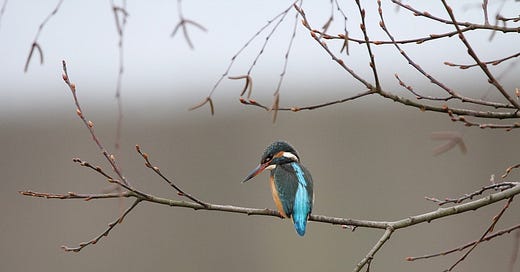Who would swap a glimpse of a kingfisher for a snatch of their whistling call?
Quite rightly, absolutely no-one. But despite their astonishing colours and wide distribution, kingfishers can be elusive, and knowing the call is a magic ticket to seeing many more of them.
To my ear the kingfisher sounds just like a dog whistle. It’s a few fast, sharp notes, given from a low branch or low in flight over a body a water.
In this recording you can hear the kingfisher at the very beginning, again at 24 seconds in, and then at intervals thereafter.
The lines that kingfisher fly, and their speed, can give rise to the Doppler effect - if you are standing on a bridge and one comes along the river towards you may notice the frequency of the call seeming to rise with the volume as it approaches, and lowering as it recedes.
And because kingfishers stick close to water whenever they can, they often take a predictable line along a stream, river or canal.
Once you pick up that whistle, scanning along the line of the water will often be rewarded with a flash of electric blue, and on a lucky day, with the bird landing nearby.
What’s more, you might be surprised where you start to find them. Picturesque ponds and wild rushing streams, all very good, but also flooded gravel pits, urban riversides and unpromising concrete culverts.
For a kingfisher, the aesthetics matters somewhat less than the quality of the fishing.
Shrieking next week: Whimbrel
When does birdsong stop? I’m looking for data on the average ‘last heard’ dates for birdsong. Can you help? > See article
Now booking at Birdsong Academy: autumn half-day walkshops in Sussex and early bird spots on the British Birdsong Essentials course (starting Feb 2022).
Media credits:
Kingfisher recording by Lawrence Shove, via the British Library
Kingfisher image by Super-M on Pixabay



